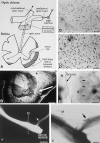Factors secreted by Schwann cells stimulate the regeneration of neonatal retinal ganglion cells
- PMID: 14690475
- PMCID: PMC1571234
- DOI: 10.1111/j.1469-7580.2004.00262.x
Factors secreted by Schwann cells stimulate the regeneration of neonatal retinal ganglion cells
Abstract
The adult mammalian central nervous system (CNS) does not repair after injury. However, we and others have shown in earlier work that the neonatal CNS is capable of repair and importantly of allowing regenerating axons to re-navigate through the same pathways as they did during development. This phase of neonatal repair is restricted by the fragility of neurons after injury and a lack of trophic factors that enable their survival. Our aim is to define better the factors that sustain neurons after injury and allow regeneration to occur. We describe some of our work using Schwann cells to promote the regeneration of neurons from young postnatal rodents. We have established rapid methods for purifying Schwann cells without the use of either anti-mitotic agents to suppress contaminating fibroblasts or mitotic stimulation to generate large numbers of Schwann cells. The rapidly purified Schwann cells have been used to generate conditioned medium that we have shown stimulates axon regeneration in cultured retinal ganglion cell neurons. We also show that the positive effects of Schwann cells are still present after pharmacological blockade of the neurotrophin receptors, suggesting that novel factors mediate these effects.
Figures




References
-
- Bampton ETW, Taylor JSH. RT-PCR analysis of neurotrophic factor expression in Schwann cells prepared by different methods. Soc. Neurosci. 2001;27:219.16.
-
- Barres BA, Silverstein BE, Corey DP, Chun LL. Immunological, morphological, and electrophysiological variation among retinal ganglion cells purified by panning. Neuron. 1988;1:791–803. - PubMed
-
- Bermingham JR, Jr, Shumas S, Whisenhunt T, Rosenfeld MG, Scherer SS. Modification of representational difference analysis applied to the isolation of forskolin-regulated genes from Schwann cells. J. Neurosci. Res. 2001;63:516–524. - PubMed
-
- Berry M, Carlile J, Hunter A. Peripheral nerve explants grafted into the vitreous body of the eye promote the regeneration of retinal ganglion cell axons severed in the optic nerve. J. Neurocytol. 1996;25:147–170. - PubMed
-
- Brockes JP, Fields KL, Raff MC. Studies on cultured rat Schwann cells. I. Establishment of purified populations from cultures of peripheral nerve. Brain Res. 1979;165:105–118. - PubMed
Publication types
MeSH terms
LinkOut - more resources
Full Text Sources
Other Literature Sources

